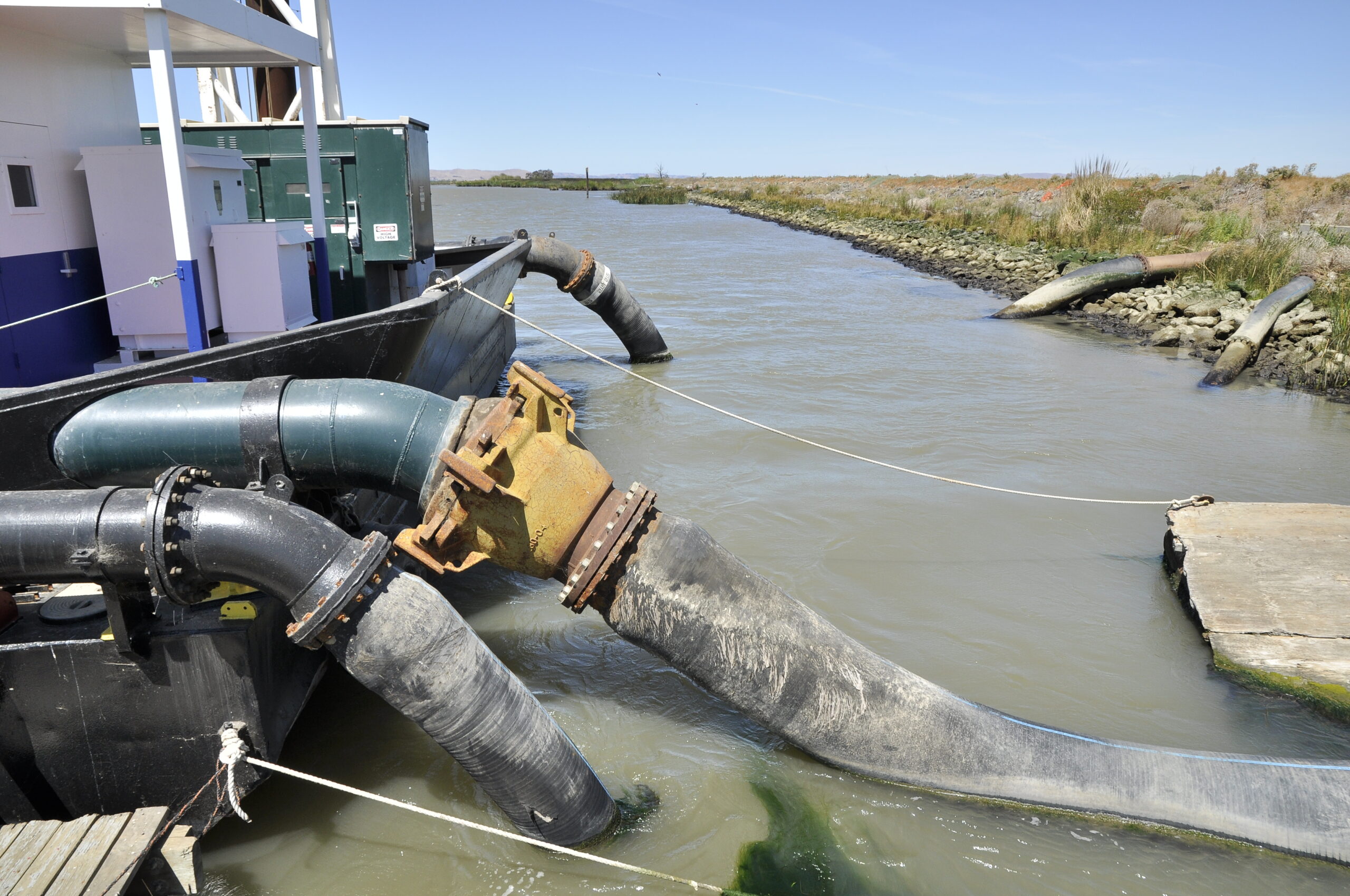
Imagine a complex of tidal wetlands skirting San Pablo Bay unbroken from China Camp to Mare Island, providing vital wildlife habitat and protecting inland communities from storm surge and sea-level rise. With stretches of this shoreline formerly diked and drained (or in Hamilton Wetlands’ case, converted to a military airfield), reconnecting it may have once seemed unlikely. Yet today just two gaps remain, one of which is included in a restoration project that’s already underway: Bel Marin Keys. And it’s a doozy.
The problem is one of scope—and more specifically of mud. The project site, currently partitioned into fields for agricultural use by a grid of berms and drainage ditches, is so large (1,900 acres), and the land so subsided that breaching its Bay-fronting concrete-and-riprap levee would flood much of the property, berms included, with multiple feet of saltwater.
Hence the need for mud: initial designs called for about 14 million cubic yards of it, to raise the elevation sufficiently to allow for the formation of new tidal marsh and transition zone habitat. That’s a huge amount of sediment, the equivalent of roughly a million large dump truck loads—or 14 years’ worth of dredged material from the Port of Oakland, which in the late 2000s provided 3.5 million cubic yards to the Hamilton Wetlands Restoration Project immediately south of Bel Marin Keys.
Without more mud, the project can’t be completed. Numerous potential sources exist, but none have yet to be secured. And given a limited (and declining) supply of sediment in the Bay system, with other restoration sites like Montezuma Wetlands in Suisun and Cullinan Ranch on the north side of Highway 37 also in need, it’s a zero-sum game with no easy answers.

“It really becomes this challenge of, ‘Where does the sediment come from and how do we get it there?’” says Julie Beagle, an environmental planning section chief with the US Army Corps of Engineers and expert on the use of dredged sediment for marsh restoration.
The reality is that it’s looking increasingly likely the project must make do with less than the full 14 million cubic yards, says Jessica Davenport, a project lead with the California State Coastal Conservancy. “The Corps and the Conservancy will be exploring ways to construct the project with a smaller volume of dredged material,” she says. “Filling the site to capacity…is looking impractical. We will be considering how to make the best use of a smaller volume of imported sediment, with the exact amount still to be determined.”
Not only that, but the source—and delivery method—of the mud still must be settled. Project planners are considering a host of approaches for Bel Marin Keys, some informed by past restoration projects on San Pablo Bay, Davenport says. These include running a pipe across the site to deliver sediment from dredge projects, as was done at Hamilton; building habitat islands from available material, then opening the site and letting it naturally accrete at a slower pace, as was done at Sears Point (which sits next door to the other remaining gap in San Pablo Bay marsh, Tubbs Island); and dividing the site into cells for a phased or multi-method approach, as at Cullinan Ranch.

Other ideas being explored include drawing sediment from and subsequently refilling an “aquatic transfer facility” on the Bay floor, and connecting the site to Novato Creek for sediment delivery, Beagle notes.
Add another question to the list: How long will all this take? “If it takes 20 years to do a project, and we know 2030 is this magic time where marshes need to be in place in order to keep pace with sea-level rise, which is what the Baylands Goals told us ….” Well, that’s not ideal. “We want to get these projects done,” she says. The “landscape-scale” size of Bel Marin Keys, and its connectivity to a restored Hamilton next door, make its impact, and urgency, all the greater.
Some critical work has already been completed. A new outboard levee built in 2021, about a mile landward of the existing levee fronting San Pablo Bay, snakes its way from north to south just in front of the Bel Marin Keys housing development. Behind it, new seasonal wetlands and alkali meadows have been constructed. But between it and the open Bay to the east lie acres upon acres of subsided agricultural fields that must be dealt with before the water can be allowed to rush back in.
To help move the project along, the Conservancy recently contracted with an engineering consultant that will lead a series of design charrettes, Davenport says. In addition to evaluating concepts generated through that process, “the Corps will conduct value engineering, a review process that will seek ways to reduce cost while still delivering the desired ecological functions,” she adds.
A tentative schedule outlined by the Corps anticipates that plans and permits will be complete by 2026 and a construction contract awarded by 2027. Sediment placement should take place over the ensuing decade, with the big moment—the levee breach—finally occurring around 2037.
Top Photo: Techniques used to add sediment to the Montezuma Wetlands included hosing it from a sediment laden barge. Photo: Darren Graffuis